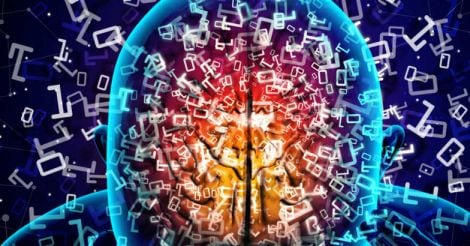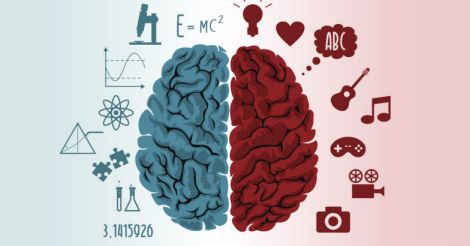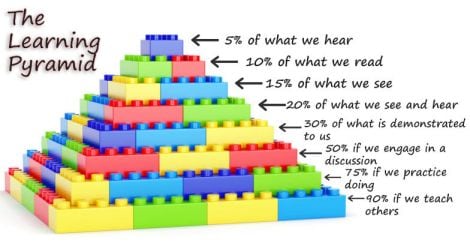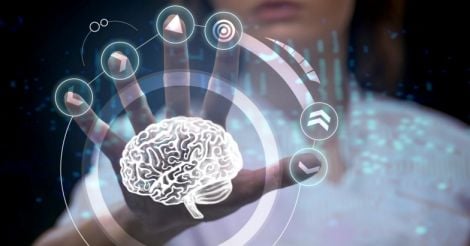Early civilizations didn’t think much of the human brain. The ancient Egyptians believed that it was a useless organ, and called it by a word that translates roughly as 'skull offal'. When they mummified their pharaohs, they would tug out the brain through the monarch’s nose, using a hook, and toss it away – while carefully preserving the liver, intestines and lungs in their own sacred canopic jars. Aristotle, in the 4th century B.C., also got it wrong. He deemed the heart to be the seat of intelligence, while the brain was, he said, a cooling unit for the blood.
Today, you’d think we know better, given that neuro-surgery as well as imaging techniques enable scientists to peer inside a human skull to observe a living, functioning brain. Sadly, there are far too many fables still making the rounds about that most fantastic of our organs. Many of these brain whoppers are believed and propagated even by those who should know better, among them educationists, developmental psychologists and corporate trainers.
Here are three of the most enduring myths about the human brain and learning, how they were birthed, and the truths that they suppress or supplant.
The myth – 1: We use only 10 percent of our brain
The truth: We use 100 percent of our brain

We want so much to believe this myth. In fact, the reason it refuses to die is that it would be just so great if it were true. Because, if we’re using up only 10 percent of our brain power, there’s so much more just waiting to be tapped. Naturally, there are global millions who are comforted by the prospect that the shortcut to their unfulfilled dreams lies in the fact that they just haven't quite found the secret to tap into this vast, allegedly unused cerebral reservoir.
Indeed, the 10-percent shibboleth continues to be actively promoted by hucksters trading on it with a never-ending stream of crackpot schemes and devices that promise to 'tap into the 90 percent of our brains that we don’t use'. Hundreds of authors have written hundreds of books fueling the myth. They include Uri Geller and other paranormal pushers. Geller, who made a career out of claims (and fake demos) that he could bend metal using the powers of his mind, trotted out the 10 percent myth in his book, 'Uri Geller’s Mind-Power Book'. He wrote, “Our minds are capable of remarkable, incredible feats, yet we don’t use them to their full capacity. In fact, most of us only use about 10 percent of our brains, if that. I believe that we once had full power over our minds. We had to, in order to survive, but as our world has become more sophisticated and complex we have forgotten many of the abilities we once had” (Italicized phrases emphasized in the original).
Even respected entities like ABC Television bought into this myth, purely on the untested assumption that it was true. When ABC ran its promo spots for one of its series, 'The Secret Lives of Men', the spots featured a full-screen blurb that read, 'Men only use 10 percent of their brains.'
What birthed this myth?
There is no smoking gun, but there are a number of tantalizing clues. One stream leads back to the pioneering American psychologist, William James, who lived in the late 19th and early 20th centuries. In his classic work, 'The Energies of Man', he stated that “We make use of only a small part of our possible mental and physical resources.” This, in fact, was a constant thread running through James’ works, the lament that the average person rarely achieves but a small portion of his or her potential. But James always talked in terms of one's undeveloped potential, never relating this to a specific amount of grey matter engaged, and certainly not citing any percentage of brain usage.
The generation of 'positive thinking' gurus that followed, however, were not so careful, and gradually, a 'small part of our potential' morphed into '10 percent of our brains'. The biggest boost for the self-help entrepreneurs came with the publication of one of the best-selling self-help books of all time, Dale Carnegie’s 'How to Win Friends and Influence People'. The preface to the book attributed the 10-percent-of-the-brain claim to William James. The myth has never lost its steam since.
How do we know it’s a myth?
» Evolution says so. It is obvious that the brain, like all our other organs, has been shaped by natural selection, and it strains credulity to think that evolution would have provided us with a bodily organ that’s 90 percent useless. If we needed only 10 percent of our brain, why did we evolve a much larger one?
» Energy use by the brain. Brain tissue is metabolically expensive, both to grow and to run. The brain uses up about 20 percent of the calories available to the body. That’s a lot of energy for just 10 percent of the brain.
» Brain injury causes loss of mental function(s). If we normally use only 10 percent of our brains, then injury or removal of 'unused' parts of the brain should have minor or no impact, or should go unnoticed. Yet, people who suffer head trauma, a stroke or other brain injury are frequently left with severe functional deficits. Losing far less than 90 percent of the brain can have catastrophic effects.
» Electric, magnetic and chemical stimulation find no 'dead spots' in the brain. Such stimulation has failed so far to uncover any dormant areas where no perception, emotion or movement is elicited.
» Ditto for brain imaging. PET scans and functional MRI clearly show that the vast expanse of the human brain does not lie perpetually fallow and useless like an appendix or a pair of tonsils. While certain simple tasks (such as watching television or eating) may use only a small part of the brain, over the course of a typical day just about all of the brain is used at one time or another. In fact, these scans find that, even during sleep, all parts of the brain show some level of activity. No function-less areas exist.
The bottom line: All told, the evidence suggests that there is no cerebral spare tire waiting to be mounted in service of boosting one’s academic performance, job advancement, or the pursuit of a cure for cancer or the Great Indian Novel. Sorry to burst your bubble.
The myth - 2: 'Left-brained' people are more logical and rational; 'right-brained' people are more creative and intuitive
The truth: Humans use both hemispheres of the brain for all cognitive functions

The lumpy landscape of the human brain is visibly split into a left and a right side. This structure has inspired one of the most pervasive ideas about the brain – that the left side controls logic and the right side controls creativity.
But this is a misconception, unsupported by scientific evidence. So, where did it spring from, and what did it get wrong? The left and the right sides of the brain do control different body functions such as movement and sight. Thus, the brain’s right side controls the motion of the left arm and leg and vice versa. The visual system is even more complex. Each eye has a left and right visual field. Both left visual fields are sent to the right side of the brain, and both right fields are sent to the left side. That is to say, the brain uses both sides to make a complete image of the world. So we can say with certainty that vision and movement control are two systems that rely on this left-right structure. But problems arise when we over-extend that idea to logic and creativity.
What birthed this myth? We can probably trace it way back to the mid-1800s when two neurologists, Broca and Wernicke, examined patients who had problems communicating due to injuries. They found damage to the patients’ left temporal lobes, so they suggested that language is controlled by the left side of the brain. That captured the popular imagination. Author Robert Louis Stevenson took the notion a little further, introducing the idea of a 'logical' left hemisphere competing with an 'emotional' right hemisphere, represented by his characters, Dr Jekyll and Mr Hyde.
Even psychologists took up the notion and ran with it, using it to explain differences between different personality types.
How do we know it’s a myth?
» Clinical evidence. The conjecture didn’t hold up when doctors and scientists examined patients who were missing a hemisphere, or had their two hemispheres separated. These patients showed a complete range of behaviors , both logical and creative.
» Research evidence. Later research showed that language is more localized to the left side of the brain, and attention to the right. Other aspects of communication, such as word emphasis and voice modulation are also controlled by areas in the right side of the brain. So, having even a simple conversation calls for work from both sides of the brain. One side of the brain may do more work of a particular kind, but the variation is by way of mental function rather than by individual persons.
In 2013 a research team looked at MRI brain images from more than a thousand volunteers between the ages of 7 and 29. The scans covered over 7,000 different regions of the brain and looked at how they were connected in people while they worked on small tasks.
They found:
• Heavy ‘neural traffic’ (messages being passed) in different regions.
• On average, both sides of the brain were equal in their neural networks and connectivity.
• While certain networks of neurons tended to be stronger on either the left or right hemisphere of individual brains, that side preference didn’t hold true for the entire brain. “Our data are not consistent with a whole-brain phenotype of greater ‘left-brained’ or greater ‘right-brained’ network strength across individuals,” they concluded.
Other brain-imaging studies show no evidence of the right hemisphere as a locus of creativity. And the brain recruits left as well as right sides for both, reading and maths.
» Experiential evidence. Even the idea of logic and creativity being at odds with each other doesn’t hold up well. Solving complex math problems requires inspired creativity, and many vibrant works of art have intricate logical frameworks. Almost every feat of creativity and logic carries the mark of the whole brain functioning as one.
The bottom line: There isn’t any evidence to suggest that people have dominant sides of the brain, or to support the idea of a left-right split between logic and creativity. Some people may be particularly logical or creative, but that has nothing to do with the sides of their brains.
The myth – 3: The learning pyramid – different methods of teaching lead to different percentages of retention
The truth: There is not an iota of scientific evidence to back this touted claim

If you’re in the field of education, you’ll be familiar with The Pyramid of Learning, to which teachers and corporate trainers make regular and earnest reference. Even if you’re not in this professional field, you’ll be familiar with some version of the pyramid. Despite the best efforts of researchers to lop off its head, this zombie theory keeps rising yet again and again in search of more brains.
The pyramid ranks different approaches to learning according to how they promote retention of what is learnt. It argues that more active modalities are better for long-term retention. Thus, by the tenets of this pyramid, after two weeks we tend to remember:
5% of what we hear
10% of what we read
15% of what we see (e.g., pictures)
20% of what we see and hear (e.g., audio-visual presentation)
30% of what is demonstrated to us
50% if we engage in a discussion
75% if we practice doing
90% if we teach others (e.g., making a presentation)
(There is, however, fluidity even in these percentages, depending on the message that the educator -- or the shyster – wants to send, with different users modifying them as they will).
What birthed this myth?
Way back in the mid 1940s, Edgar Dale, an expert in audio-visual education, created a model that he called the Cone of Experience. His cone made no reference to learning or retention or, for that matter, percentages. All he did was to rank levels of abstraction in the imparting of information, words being the most abstract and nesting at the top of the cone, and real-life experiences the most concrete and therefore at the base of the cone.
Dale did not value one mode over another, but argued for a wide variety of modes, depending on context. Unfortunately, this conceptual model took on a life of its own despite Dale including caveats in the several editions of his work, going up to 6 pages of disclaimers, stressing that the cone was a theoretical model, and that multiple modes could apply to situations depending on the context. All his warnings went unheeded, and the 'Cone of Experience' was misapplied and renamed the 'Learning Pyramid'.
Who first came up with the pyramid and the percentages? That remains murky, but it is most often attributed to Paul John Phillips, an instructor at a United States Army facility in Maryland during World War II. After the war, Phillips worked at the University of Texas, where he trained members of the petroleum industry. The University of Texas records tie Phillips to the retention rates used in the pyramid.
How do we know it’s a myth?
» There’s no evidence: Nothing about the pyramid is evidence-based. No conclusive scientific tests have confirmed its efficacy or its tough hypotheses. Neither the University of Texas nor the US Army facility where Phillips worked has been able to find any research to back the percentages.
The current chief propagator of the Learning Pyramid is the National Training Laboratories (NTL) Institute in the US. Queried about research evidence relating to the pyramid, NTL has stated quite blandly on record: “While we believe it to be accurate, we no longer have – nor can we find – the original research that supports the numbers.”
Nor has any other researcher been able to come up with any evidence. This complete lack of research evidence negates all credibility of the pyramid.
» The percentages seem too neat to be true. The Pyramid’s percentages, all of which are whole numbers, are just too neat and pat and rounded. Research rarely yields such clear-cut results.
» Learning is impacted by far too many variables. Many distinguished authors have gutted the pyramid’s claims, pointing out that so many variables affect learning and retention that providing an optimal learning experience does not boil down to the instruction method alone. To mention just two of the many other variables that impact learning:
• The age of the learner.
• What the learner was asked to do as (s)he read, listened, discussed or demonstrated. You can boost memory considerably for a reading lesson, for example, by asking the learners to summarize as they read.
Thus, the ordering of the activities on the pyramid could shift in every learning situation, depending on the specifics.
» It challenges common sense. With regard to the base of the pyramid, it is difficult to envisage the average human retaining 90 percent of what was learnt, regardless of the mode of learning used.
» The pyramid disproves itself. Finally, what might seem like a flip argument, but is worth a thought: The pyramid is a visual sighting. If we remember only 15 percent of what we see, then a picture of the pyramid should not have such a dramatic memory impact on so many people as it evidently does. Think about it.
(The author is a former editor of 'Health & Nutrition' magazine, and now works as a counseling therapist)
Read more at: Wellness | Body, Mind and Soul | Heal Thy Self


























 Hundreds of authors have written hundreds of books fueling the myth.
Hundreds of authors have written hundreds of books fueling the myth.




